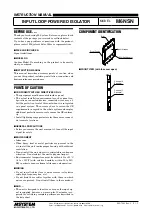
generate power in the range of 10 kW...10 MW and most of them are interconnected to the
distribution network. They can supply power into the network as well as to the local loads.
It is not common to connect generators directly to the distribution networks and thus the
distributed generation can cause some challenges for the protection of distribution
networks. From the protection point of view, one of the most challenging issue is
islanding.
Islanding is defined as a condition in which a distributed generation unit continues to
supply power to a certain part of the distribution network when power from the larger
utility main grid is no longer available after the opening of a circuit-breaker. Islanding is
also referred as Loss of Mains (LOM) or Loss of Grid (LOG). When LOM occurs, neither
the voltage or the frequency is controlled by the utility supply. These distributed
generators are not equipped with voltage and frequency control; therefore, the voltage
magnitude of an islanded network may not be kept within the desired limits which causes
undefined voltage magnitudes during islanding situations and frequency instability.
Uncontrolled frequency represents a high risk for drives and other machines. Islanding
can occur as a consequence of a fault in the network, due to circuit breaker maloperation
or due to circuit breaker opening during maintenance. If the distributed generator
continues its operation after the utility supply is disconnected, faults do not clear under
certain conditions as the arc is charged by the distributed generators. Moreover, the
distributed generators are incompatible with the current reclosing practices. During the
reclosing sequence dead time, the generators in the network tend to drift out of
synchronism with the grid and reconnecting them without synchronizing may damage the
generators introducing high currents and voltages in the neighboring network.
To avoid these technical challenges, protection is needed to disconnect the distributed
generation once it is electrically isolated from the main grid supply. Various techniques
are used for detecting Loss of Mains. However, the present function focuses on voltage
vector shift.
The vector shift detection guarantees fast and reliable detection of mains failure in almost
all operational conditions when a distributed generation unit is running in parallel with the
mains supply, but in certain cases this may fail.
If the active and reactive power generated by the distributed generation units is nearly
balanced (for example, if the power mismatch or unbalance is less than 5...10%) with the
active and reactive power consumed by loads, a large enough voltage phase shift may not
occur which can be detected by the vector shift algorithm. This means that the vector shift
algorithm has a small non-detection-zone (NDZ) which is also dependent on the type of
generators, loads, network and pickup or trip value of the vector shift algorithm. Other
network events like capacitor switching, switching of very large loads in weak network or
connection of parallel transformer at HV/MV substation, in which the voltage magnitude
is not changed considerably (unlike in faults) can potentially cause maloperation of vector
shift algorithm, if very sensitive settings are used.
1MAC059074-MB A
Section 4
Protection functions
615 series ANSI
669
Technical Manual
Summary of Contents for Relion 615 series
Page 1: ... RELION PROTECTION AND CONTROL 615 series ANSI Technical Manual ...
Page 2: ......
Page 39: ...Section 17 Glossary 1181 Table of contents 615 series ANSI 33 Technical Manual ...
Page 40: ...34 ...
Page 64: ...58 ...
Page 216: ...210 ...
Page 884: ...878 ...
Page 1038: ...1032 ...
Page 1136: ...1130 ...
Page 1172: ...1166 ...
Page 1180: ...1174 ...
Page 1186: ...1180 ...
Page 1192: ...1186 ...
Page 1193: ...1187 ...
Page 1194: ......
Page 1195: ......
















































